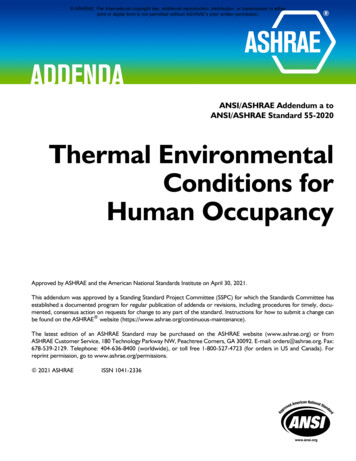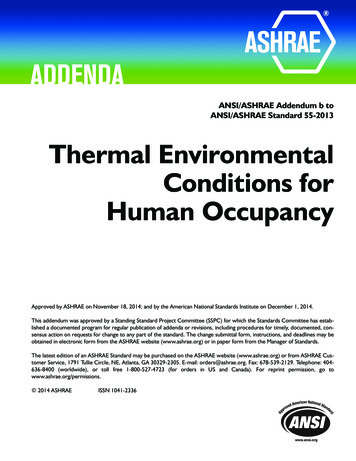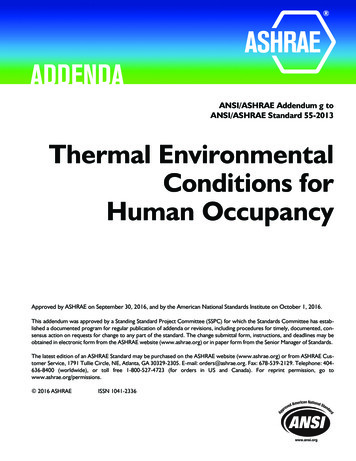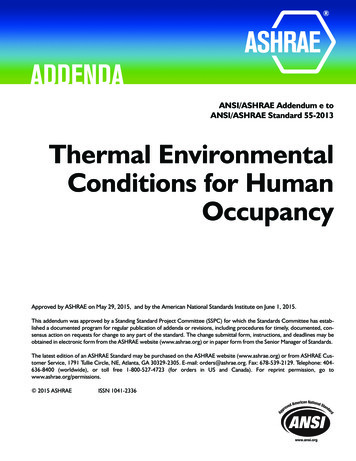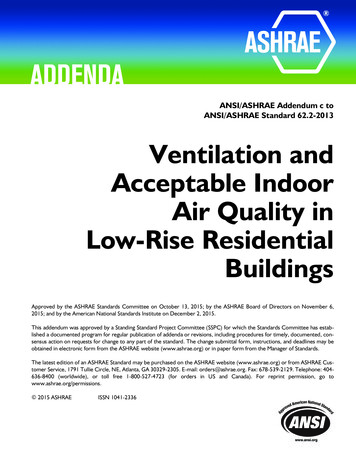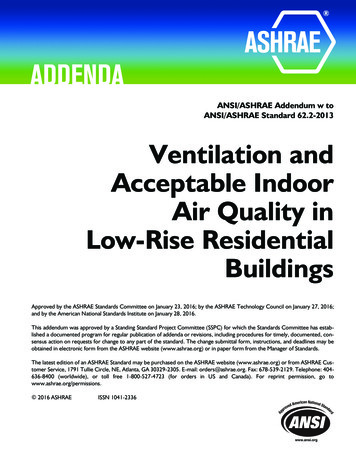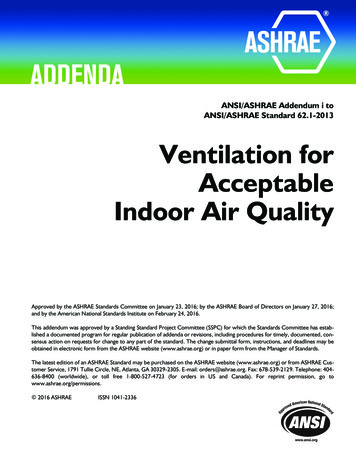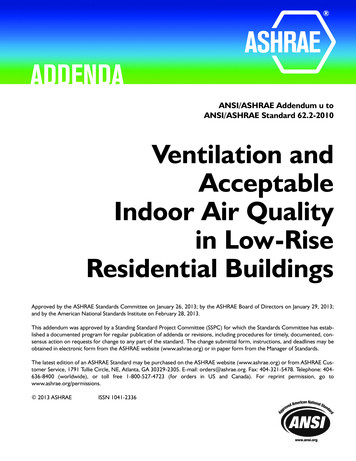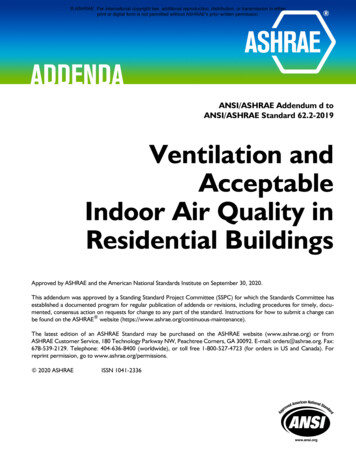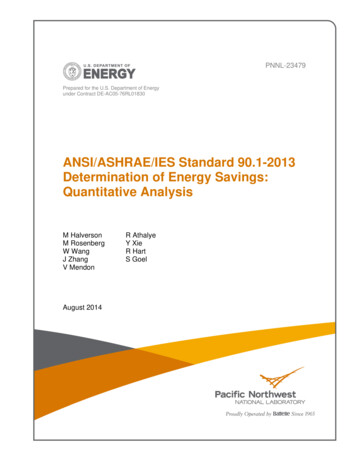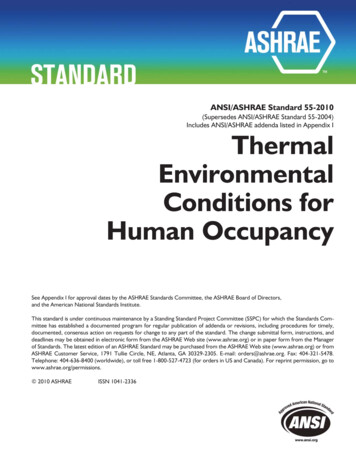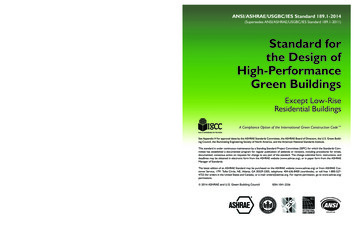
Transcription
189 1 2014 cover.fm Page 1 Monday, November 3, 2014 1:53 PMAbout ASHRAEASHRAE, founded in 1894, is a global society advancing human well-being through sustainable technology for the builtenvironment. The Society and its members focus on building systems, energy efficiency, indoor air quality, refrigeration,and sustainability. Through research, standards writing, publishing, certification and continuing education, ASHRAEshapes tomorrow’s built environment today.For more information or to become a member of ASHRAE, visit www.ashrae.org.To stay current with this and other ASHRAE standards and guidelines, visit www.ashrae.org/standards.Visit the ASHRAE BookstoreASHRAE offers its standards and guidelines in print, as immediately downloadable PDFs, on CD-ROM, and via ASHRAEDigital Collections, which provides online access with automatic updates as well as historical versions of publications.Selected standards are also offered in redline versions that indicate the changes made between the active standard andits previous version. For more information, visit the Standards and Guidelines section of the ASHRAE Bookstore atwww.ashrae.org/bookstore.IMPORTANT NOTICES ABOUT THIS STANDARDTo ensure that you have all of the approved addenda, errata, and interpretations for thisstandard, visit www.ashrae.org/standards to download them free of charge.Addenda, errata, and interpretations for ASHRAE standards and guidelines are nolonger distributed with copies of the standards and guidelines. ASHRAE providesthese addenda, errata, and interpretations only in electronic form to promotemore sustainable use of resources.Product code: 8660612/14ANSI/ASHRAE/USGBC/IES Standard 189.1-2014 Standard for the Design of High-Performance Green Buildings Except Low-Rise Residential BuildingsASHRAE · 1791 Tullie Circle NE · Atlanta, GA 30329 · www.ashrae.orgANSI/ASHRAE/USGBC/IES Standard 189.1-2014(Supersedes ANSI/ASHRAE/USGBC/IES Standard 189.1-2011)Standard forthe Design ofHigh-PerformanceGreen BuildingsExcept Low-RiseResidential BuildingsA Compliance Option of the International Green Construction Code See Appendix H for approval dates by the ASHRAE Standards Committee, the ASHRAE Board of Directors, the U.S. Green Building Council, the Illuminating Engineering Society of North America, and the American National Standards Institute.This standard is under continuous maintenance by a Standing Standard Project Committee (SSPC) for which the Standards Committee has established a documented program for regular publication of addenda or revisions, including procedures for timely,documented, consensus action on requests for change to any part of the standard. The change submittal form, instructions, anddeadlines may be obtained in electronic form from the ASHRAE website (www.ashrae.org), or in paper form from the ASHRAEManager of Standards.The latest edition of an ASHRAE Standard may be purchased on the ASHRAE website (www.ashrae.org) or from ASHRAE Customer Service, 1791 Tullie Circle, NE, Atlanta, GA 30329-2305, telephone: 404-636-8400 (worldwide), or toll free 1-800-5274723 (for orders in the United States and Canada), or e-mail: orders@ashrae.org. For reprint permission, go to www.ashrae.org/permissions. 2014 ASHRAE and U.S. Green Building CouncilISSN 1041-2336
ASHRAE Standard Project Committee 189.1Cognizant TC: TC 2.8, Building Environmental Impacts and SustainabilitySPLS Liaison: Patricia T. GraefASHRAE Staff Liaison: Bert E. EtheredgeIES Liaison: Rita M. HarroldUSGBC Liaison: Brendan OwensNameNameAndrew K. Persily*, ChairBoggarm S. Setty*Lawrence J. Schoen, Vice-Chair *Wayne H. Stoppelmoor, Jr.*Leon E. Alevantis*Wesley Sullens*Jeffrey G. Boldt*Christian R. Taber*Lee W. Burgett*Martha G. VanGeem*Ron Burton*Daniel C. Whittet*Dimitri S. Contoyannis*David T. Williams*Drury B. Crawley*Jian Zhang*John P. Cross*Charles J. Bertuch, IIIJennifer R. DolinConstantinos A. BalarasCharles N. Eley*Daryn S. ClineAnthony C. Floyd*Ernest A. ConradSusan Gitlin*Francis M. GalloGregg Gress*Gregory C. JohnsonDonald Horn*John KoellerRoy S. Hubbard, Jr.*George O. Lea, Jr.Josh Jacobs*Darren Molnar-PortMichael Jouaneh*Gwelen PaliagaThomas M. Lawrence*Xiufeng PangNeil P. Leslie*Lori-Ann L. PolukoshkoRichard Lord*Joseph G. RiddleMerle F. McBride*Michael SchmeidaMolly E. McGuire*Charles J. SeyfferJonathan R. McHugh*Matt SiglerThomas E. Pape*Kent A. SovocoolTeresa M. Rainey*Dennis A. StankeSteven Rosenstock*Scott P. WestJeff Ross-Bain*Jianshun S. Zhang* Denotes members of voting status when the document was approved for publication.POLICY STATEMENT DEFINING ASHRAE’S CONCERNFOR THE ENVIRONMENTAL IMPACT OF ITS ACTIVITIESASHRAE is concerned with the impact of its members’ activities on both the indoor and outdoor environment. ASHRAE’smembers will strive to minimize any possible deleterious effect on the indoor and outdoor environment of the systems andcomponents in their responsibility while maximizing the beneficial effects these systems provide, consistent with acceptedstandards and the practical state of the art.ASHRAE’s short-range goal is to ensure that the systems and components within its scope do not impact the indoor andoutdoor environment to a greater extent than specified by the standards and guidelines as established by itself and otherresponsible bodies.As an ongoing goal, ASHRAE will, through its Standards Committee and extensive technical committee structure,continue to generate up-to-date standards and guidelines where appropriate and adopt, recommend, and promote those newand revised standards developed by other responsible organizations.Through its Handbook, appropriate chapters will contain up-to-date standards and design considerations as the material issystematically revised.ASHRAE will take the lead with respect to dissemination of environmental information of its primary interest and will seekout and disseminate information from other responsible organizations that is pertinent, as guides to updating standards andguidelines.The effects of the design and selection of equipment and systems will be considered within the scope of the system’sintended use and expected misuse. The disposal of hazardous materials, if any, will also be considered.ASHRAE’s primary concern for environmental impact will be at the site where equipment within ASHRAE’s scopeoperates. However, energy source selection and the possible environmental impact due to the energy source and energytransportation will be considered where possible. Recommendations concerning energy source selection should be made byits members.Jim Bowman*
ASHRAE STANDARDS COMMITTEE 2014–2015Richard L. Hall, ChairDouglass T. Reindl, Vice-ChairJoseph R. AndersonJames Dale AsweganCharles S. BarnabyDonald M. BrundageJohn A. ClarkWaller S. ClementsDavid R. ConoverJohn F. DunlapJames W. Earley, Jr.Steven J. EmmerichPatricia T. GraefRita M. HarroldAdam W. HingeSrinivas KatipamulaDebra H. KennoyMalcolm D. KnightRick A. LarsonArsen K. MelkovMark P. ModeraCyrus H. NasseriHeather L. PlattPeter SimmondsWayne H. Stoppelmoor, Jr.Jack H. ZarourJulia A. Keen, BOD ExOBjarne Wilkens Olesen, COStephanie C. Reiniche, Manager of StandardsSPECIAL NOTEThis American National Standard (ANS) is a national voluntary consensus standard developed under the auspices of the AmericanSociety of Heating, Refrigerating and Air-Conditioning Engineers (ASHRAE). Consensus is defined by the American National StandardsInstitute (ANSI), of which ASHRAE is a member and which has approved this standard as an ANS, as “substantial agreement reached bydirectly and materially affected interest categories. This signifies the concurrence of more than a simple majority, but not necessarily unanimity.Consensus requires that all views and objections be considered, and that an effort be made toward their resolution.” Compliance with thisstandard is voluntary until and unless a legal jurisdiction makes compliance mandatory through legislation.ASHRAE obtains consensus through participation of its national and international members, associated societies, and public review.ASHRAE Standards are prepared by a Project Committee appointed specifically for the purpose of writing the Standard. The ProjectCommittee Chair and Vice-Chair must be members of ASHRAE; while other committee members may or may not be ASHRAE members, allmust be technically qualified in the subject area of the Standard. Every effort is made to balance the concerned interests on all ProjectCommittees.The Manager of Standards of ASHRAE should be contacted for:a. interpretation of the contents of this Standard,b. participation in the next review of the Standard,c. offering constructive criticism for improving the Standard, ord. permission to reprint portions of the Standard.DISCLAIMERASHRAE uses its best efforts to promulgate Standards and Guidelines for the benefit of the public in light of available information andaccepted industry practices. However, ASHRAE does not guarantee, certify, or assure the safety or performance of any products, components,or systems tested, installed, or operated in accordance with ASHRAE’s Standards or Guidelines or that any tests conducted under itsStandards or Guidelines will be nonhazardous or free from risk.ASHRAE INDUSTRIAL ADVERTISING POLICY ON STANDARDSASHRAE Standards and Guidelines are established to assist industry and the public by offering a uniform method of testing for ratingpurposes, by suggesting safe practices in designing and installing equipment, by providing proper definitions of this equipment, and by providingother information that may serve to guide the industry. The creation of ASHRAE Standards and Guidelines is determined by the need for them,and conformance to them is completely voluntary.In referring to this Standard or Guideline and in marking of equipment and in advertising, no claim shall be made, either stated or implied,that the product has been approved by ASHRAE.
CONTENTSANSI/ASHRAE/USGBC/IES Standard 189.1-2014,Standard for the Design of High-Performance Green BuildingsExcept Low-Rise Residential BuildingsSECTIONPAGEForeword .41 Purpose.62 Scope .63 Definitions, Abbreviations, and Acronyms.64 Administration and Enforcement .125 Site Sustainability.136 Water Use Efficiency.187 Energy Efficiency .228 Indoor Environmental Quality (IEQ) .329 The Building’s Impact on the Atmosphere, Materials, and Resources.3910 Construction and Plans for Operation .4311 Normative References.50Normative Appendix A: Climate Zones and Prescriptive Building Envelope and Duct Insulation Tables .58Normative Appendix B: Prescriptive Equipment Efficiency Tables for the Alternate ReducedRenewables and Increased Equipment Efficiency Approach in Section 7.4.1.1.2.63Normative Appendix C: Performance Option for Energy Efficiency .96Normative Appendix D: Building Concentrations .101Informative Appendix E: Building Envelope Tables.102Informative Appendix F: Integrated Design .119Informative Appendix G: Informative References.121Informative Appendix H: Addenda Description Information.124NOTEApproved addenda, errata, or interpretations for this standard can be downloaded free of charge from the ASHRAEWeb site at www.ashrae.org/technology. 2014 ASHRAEand U.S. Green Building Council1791 Tullie Circle NE · Atlanta, GA 30329 · www.ashrae.org · All rights reserved.ASHRAE is a registered trademark of the American Society of Heating, Refrigerating and Air-Conditioning Engineers, Inc.ANSI is a registered trademark of the American National Standards Institute.
(This foreword is not part of this standard. It is merelyinformative and does not contain requirements necessaryfor conformance to the standard. It has not been processed according to the ANSI requirements for a standardand may contain material that has not been subject topublic review or a consensus process. Unresolved objectors on informative material are not offered the ri
ASHRAE Standards are prepared by a Project Committee appointed specifically for the purpose of writing the Standard. The Project Committee Chair andVice-Chair must be members of ASHRAE; while other committee members may or may not be ASHRAE members, all must be technically qualified in the subject area of the Standard. Every effort is made to balance the concerned interests on all Project .

